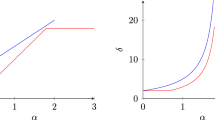Abstract
Consider the long-range models on \({\mathbb{Z}^d}\) of random walk, self-avoiding walk, percolation and the Ising model, whose translation-invariant 1-step distribution/coupling coefficient decays as \({|x|^{-d-\alpha}}\) for some \({\alpha > 0}\) . In the previous work (Chen and Sakai in Ann Probab 43:639–681, 2015), we have shown in a unified fashion for all \({\alpha\ne2}\) that, assuming a bound on the “derivative” of the \({n}\) -step distribution (the compound-zeta distribution satisfies this assumed bound), the critical two-point function \({G_{p_{\rm c}}(x)}\) decays as \({|x|^{\alpha\wedge2-d}}\) above the upper-critical dimension \({d_{\rm c}\equiv(\alpha\wedge2)m}\) , where m = 2 for self-avoiding walk and the Ising model and m = 3 for percolation. In this paper, we show in a much simpler way, without assuming a bound on the derivative of the n-step distribution, that \({G_{p_{\rm c}}(x)}\) for the marginal case α = 2 decays as \({|x|^{2-d}/\log|x|}\) whenever d ≥ dc (with a large spread-out parameter L). This solves the conjecture in Chen and Sakai (2015), extended all the way down to d = dc, and confirms a part of predictions in physics (Brezin et al. in J Stat Phys 157:855–868, 2014). The proof is based on the lace expansion and new convolution bounds on power functions with log corrections.
Similar content being viewed by others
References
Aizenman M.: Geometric analysis of \({\phi^4}\) fields and Ising models. Commun. Math. Phys. 86, 1–48 (1982)
Aizenman M., Barsky D.J.: Sharpness of the phase transition in percolation models. Commun. Math. Phys. 108, 489–526 (1987)
Aizenman M., Barsky D.J., Fernández R.: The phase transition in a general class of Ising-type models is sharp. J. Stat. Phys. 47, 343–374 (1987)
Aizenman M., Duminil-Copin H., Sidoravicius V.: Random currents and continuity of Ising model’s spontaneous magnetization. Commun. Math. Phys. 334, 719–742 (2015)
Aizenman M., Fernández R.: On the critical behavior of the magnetization in high-dimensional Ising models. J. Stat. Phys. 44, 393–454 (1986)
Aizenman M., Newman C.M.: Tree graph inequalities and critical behavior in percolation models. J. Stat. Phys. 36, 107–143 (1984)
Angelini MC, Parisi G, Ricci-Tersenghi F: Relation between short-range and long-range Ising models. Phys. Rev. E 89, 062120 (2014)
Brezin E., Parisi G., Ricci-Tersenghi F.: The crossover region between long-range and short-range interactions for the critical exponents. J. Stat. Phys. 157, 855–868 (2014)
Brydges D., Spencer T.: Self-avoiding walk in 5 or more dimensions. Commun. Math. Phys. 97, 125–148 (1985)
Chen L.-C., Sakai A.: Critical behavior and the limit distribution for long-range oriented percolation. I. Probab. Theory Relat. Fields 142, 151–188 (2008)
Chen L.-C., Sakai A.: Critical behavior and the limit distribution for long-range oriented percolation. II: spatial correlation. Probab. Theory Relat. Fields 145, 435–458 (2009)
Chen L.-C., Sakai A.: Asymptotic behavior of the gyration radius for long-range self-avoiding walk and long-range oriented percolation. Ann. Probab. 39, 507–548 (2011)
Chen L.-C., Sakai A.: Critical two-point functions for long-range statistical-mechanical models in high dimensions. Ann. Probab. 43, 639–681 (2015)
Duminil-Copin H., Tassion V.: A new proof of the sharpness of the phase transition for Bernoulli percolation and the Ising model. Commun. Math. Phys. 343, 725–745 (2016)
Hara T.: Decay of correlations in nearest-neighbour self-avoiding walk, percolation, lattice trees and animals. Ann. Probab. 36, 530–593 (2008)
Hara T., Hofstad R., Slade G.: Critical two-point functions and the lace expansion for spread-out high-dimensional percolation and related models. Ann. Probab. 31, 349–408 (2003)
Hara T., Slade G.: Mean-field critical behaviour for percolation in high dimensions. Commun. Math. Phys. 128, 333–391 (1990)
Hara T., Slade G.: On the upper critical dimension of lattice trees and lattice animals. J. Stat. Phys. 59, 1469–1510 (1990)
Heydenreich M., van derHofstad R., Sakai A.: Mean-field behavior for long- and finite-range Ising model, percolation and self-avoiding walk. J. Stat. Phys. 132, 1001–1049 (2008)
Lebowitz J.: GHS and other inequalities. Commun. Math. Phys. 35, 87–92 (1974)
Lohmann M., Slade G., Wallace B.C.: Critical two-point function for long-range O(n) models below the upper critical dimension. J. Stat. Phys. 169, 1132–1161 (2017)
Madras N., Slade G.: The Self-Avoiding Walk. Birkhäuser, Basel (1993)
Menshikov M.V.: Coincidence of critical points in percolation problems. Soviet Math. Doklady 33, 856–859 (1986)
Nguyen B.G., Yang W-S.: Triangle condition for oriented percolation in high dimensions. Ann. Probab. 21, 1809–1844 (1993)
Sakai A.: Mean-field critical behavior for the contact process. J. Stat. Phys. 104, 111–143 (2001)
Sakai A.: Lace expansion for the Ising model. Commun. Math. Phys. 272, 283–344 (2007)
Sakai A.: Application of the lace expansion to the \({\varphi^4}\) model. Commun. Math. Phys. 336, 619–648 (2015)
Acknowledgments
The work of AS was supported by JSPS KAKENHI Grant Number 18K03406. The work of LCC was supported by the Grant MOST 107-2115-M-004-004-MY2. We are grateful to the Institute of Mathematics and Mathematics Research Promotion Center (MRPC) of Academia Sinica, as well as the National Center for Theoretical Sciences (NCTS) at National Taiwan University, for providing us with comfortable working environment in multiple occasions. We would also like to thank the referees for their comments to improve presentation of this paper.
Author information
Authors and Affiliations
Corresponding author
Additional information
Communicated by H. Spohn
Publisher’s Note
Springer Nature remains neutral with regard to jurisdictional claims in published maps and institutional affiliations.
Rights and permissions
About this article
Cite this article
Chen, LC., Sakai, A. Critical Two-Point Function for Long-Range Models with Power-Law Couplings: The Marginal Case for \({d\ge d_{\rm c}}\). Commun. Math. Phys. 372, 543–572 (2019). https://doi.org/10.1007/s00220-019-03385-9
Received:
Accepted:
Published:
Issue Date:
DOI: https://doi.org/10.1007/s00220-019-03385-9



